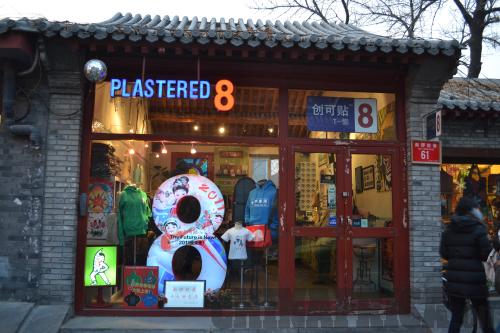|
 |
|
Plastered T-shirts (LIU JIAN) |
Tourists traveling to Beijing always have the Great Wall, Tiananmen Square and the Forbidden City on their must-see list. But what if you have already seen the sights? Then it's time to explore the ancient capital's hutongs. Featured this issue is Nanluoguxiang Alley, one of downtown Beijing's best preserved hutongs. With its grey-walled courtyard homes, it offers a real taste of traditional city life.
Located several kilometers north of the Forbidden City and east of Houhai Lake, Nanluoguxiang Alley is a 786-meter-long and 8-meter-wide lane. It stretches north-south from Gulou East Street to Di'anmen East Street.
Built in 1267, the lane was originally called Luoguo Alley (which translates as "hunchback alley") in the Ming Dynasty (1368-1644) because its middle section was higher than its ends. This lane was divided into Nanluoguxiang Alley and Beiluoguxiang Alley in 1750.
A flourishing commercial street during the Yuan Dynasty (1279-1368), the area became a popular residential area for government officials, intellectuals and wealthy families during the Ming and Qing (1644-1911) dynasties. Organized in the traditional Chinese courtyard style, many of these residences still stand today.
Nanluoguxiang Alley was built under the architectural concept of "residential blocks." The lane serves as an axis dividing eight parallel hutongs on each side, like a fish skeleton or a centipede – thus its nickname "Centipede Street."
With a history going back 700 years, the lane is a blend of past and present, having received a face lift in early 2006. Its road was paved with grey bricks, storefronts were renovated, and over 50 cafes, bars, shops and restaurants were opened. The area has since become a favorite spot for local hipsters, musicians and freelancers, attracting foreigners and locals alike who roam the alley past midnight.
Unlike other bar streets, Nanluoguxiang Alley has a distinct cultural feel to it. Various store owners are gifted artists and writers. For example, the owner of Cafe de Margarita (at No.36 Nanluoguxiang Alley), a short story writer, was inspired by the area to start her own establishment.
While life in Beijing is fast paced, Nanluoguxiang Alley seems to be a place absent of hurrying and haste. Tourists meander around ancient courtyards, discover unique handicrafts in small boutiques and sip coffee in cozy cafes. Modernity and tradition combined together make the lane a hip street in an ancient capital.
Hutong Tips
How to get there
>By subway: Take subway Line 5, get off at Beixinqiao Station or Zhangzizhonglu Station, the alley is a short taxi ride from either stop.
>By bus: Take bus 13/107/118/701/823/834/850, and get off at Luoguxiang Station
Where to stay
>Travelers looking for a different experience may try a youth hostel in the area like Beijing Downtown Backpackers Accommodation, which is outfitted with a popular cozy cafe, Internet access, coffee and breakfast.
Address: No.85 Nanluoguxiang Alley
Price: single room: 160 yuan/Room; double room: 210 yuan /Room
Website: www.backpackingchina.com
What to buy
>At Community Arts Co-op, find a variety of traditional Beijing handicrafts made by senior folk artisans, such as paper-cuttings and facial make-up used in Peking opera.
Address: No.13 Nanluoguxiang Alley
>Plastered T-shirts captures the essence of China and plasters it on T-shirts. Plastered has given China a brand to call its own and is Beijing's first, original T-shirt brand.
Address: No.61 Nanluoguxiang Alley
Website: www.plasteredtshirts.com |